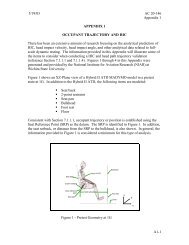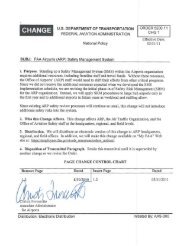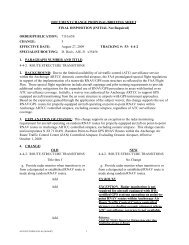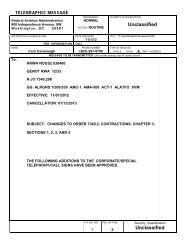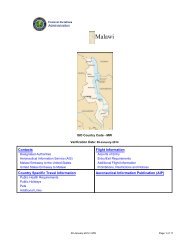2009 SMS Pilot Project (SMSPP) Analysis - FAA
2009 SMS Pilot Project (SMSPP) Analysis - FAA
2009 SMS Pilot Project (SMSPP) Analysis - FAA
Create successful ePaper yourself
Turn your PDF publications into a flip-book with our unique Google optimized e-Paper software.
3. Determine which D&M <strong>SMS</strong> framework expectations indicate a need for new<br />
approaches, processes, and information.<br />
4. Provide the basis for establishing an implementation plan to close the gaps.<br />
M<strong>SMS</strong> Team Observations During the DGA<br />
During the DGA, many participants struggled to fit the assessment scale to the maturity of their<br />
existing systems. Several participants found their procedures and processes fit in some areas of<br />
the scale, and other procedures and processes were in between on the assessment scale. In this<br />
case, they had to choose between the higher or lower scale values. Most participants chose the<br />
lower value to be more conservative and to prevent skewing the results.<br />
Several pilot participants expanded the scope of their initial <strong>SMS</strong> system description to apply to<br />
more areas after they saw the benefits.<br />
Some D&M organizations have existing and mature safety systems and processes that meet or<br />
exceed part 21 regulatory requirements, such as certification processes, QMS, internal audits,<br />
and COS programs. Many organizations have a lot of of the <strong>SMS</strong> procedures and processes in<br />
place but were missing only certain aspects of the <strong>SMS</strong> elements that were necessary to close the<br />
gap.<br />
<strong>SMS</strong> Implementation Plan<br />
Based on the results of the DGA process, an implementation plan is prepared to fill the gaps<br />
between the organizations’ existing processes and what the D&M <strong>SMS</strong> framework requires. The<br />
<strong>SMS</strong> implementation plan is a realistic approach on how to implement an <strong>SMS</strong> to meet safety<br />
objectives. It describes in detail how and when the organization will achieve its corporate safety<br />
objectives and how it will meet any new or revised safety requirements, regulatory or otherwise.<br />
As the organizations progress through each level (1 through 4), the top management must<br />
approve the implementation plan and allocate necessary staffing and resources. The<br />
implementation plan also describes who is responsible for tracking and validating the<br />
implementation of each new or revised procedure and/or process. The implementation plan<br />
focuses on the <strong>SMS</strong> within the scope of the participant’s system description.<br />
The GAT includes a worksheet (pre-populated with the gaps identified from the DGA) to help<br />
create the implementation plan. The implementation plan need not be complex or excessively<br />
detailed, but it should provide a basic roadmap to meet the overall objective stated in the <strong>SMS</strong><br />
framework. The implementation plan should also span the entire <strong>SMS</strong> development process<br />
through all levels of maturity and should be updated as necessary (along with the DGA) as the<br />
projects progress. The organization’s <strong>SMS</strong> planning group should meet regularly with top<br />
management to assess progress of the implementation plan and receive commensurate resources.<br />
27



